
Miltiadis Zermpoulis
Heuristic displays of photographic images inside the home: Greek family photographs as efficient agents of an appropriate past, proper present and inspired future((The photographic material used in this article has been reformatted in order to protect the anonymity of my informants according the ethical issues of an ethnographic research. Additionally for the same reason all the names that have been used in this article are pseudonyms.))
Dans la Grèce d'après la Seconde Guerre mondiale, la photographie a aussi constitué un marqueur d'appartenance et de prestige pour la bourgeoisie de la ville de Thessalonique. Miltiadis Zerboulis montre dans son article comment ces images continuent aujourd'hui à jouer un rôle actif dans la façon de raconter et de mettre en scène l'histoire familiale dans son articulation à l'histoire collective.
The recollections regarding the difficult decade of the 1940s; the two Wars, the experiences of loss and harshness are almost always at the centre of the first discussions with my informants in Thessaloniki. The contemporary economic crisis in Greece also dramatically influences their need to go back in time and remember the years of material and human disaster. All their possessions displayed inside their homes show that the achievements of a whole life can in a single moment get lost or be passed on to different owners.
However for my doctoral research project I am more interested in the impact of the social and economic changes after the end of the civil war (1949), when Greece both politically and also on the level of the everyday life was “trying to belong to the West”.((This phrase belongs to Kostantinos Karamanlis, Greek minister, four- time prime minister of the state and twice President of Hellenic Republic. Specifically is part of a speech that Karamanlis held in the Greek parliament on 12th June 1976, where he declares emphatically his conviction that “Greece belongs culturally, economically, politically and military to the west”, see the popular speech in https://www.youtube.com/watch?v=51DbXntglI )) I wish to understand if there is a culture connected to imagined European and generally western values and also the possibility of a better way to be Greek that was constructed in the post-war era and linked to particular middle classes((With middle classes I try to interpret the indigenous self-determination of my informants, who feel to belong to a Greek middle class. I use the plural form ‘classes’ thinking of various groups of people and a cultural constructed category of class (regarding the use of social class as a category of analysis see Avdela 1995:173-204).)), which is continually demonstrated and reconstructed through discourses and practices in the everyday life. Specifically, I am searching for the construction of different subjectivities related to the power relations of post-war Greek society and the formation of a hegemonic Greek culture in the framework of the cold war, trying to see and interpret them in their everyday construction and reproduction through social practices inside and outside the home. Power is not only a tool that can be exerted by the state being as Bourdieu(1999: 57) pointed out “the culmination of a process of concentration of different species of capital” but rather being conceived as something dispersed as Foucault (1999:131-144) described it, suggesting focusing on self-governing technologies regarding individuals and national populations. In this article we try to understand how heuristic displays of photographs inside the home reproduce, in a performative and discursive way, the structure of inequality and social distinction related to particular post-war subjectivities, inspiring present life styles that have to be maintained for posterity.
The study focuses on recollections regarding consumption and decoration practices aiming to see them in the scheme of the post-war state policies of urbanization and real estate development in Greece (Maloutas 1990: 17; Oikonomou 2008:128-140). As part of my fieldwork in Thessaloniki from 2012 to 2015 I visited 25 houses and always began with discussions about the inhabitants, family and their life in this city. My informant group consists of people from two different generations; the first born in the late 1930s and the second in the late 1950s. The informants almost all had migration backgrounds and felt that they belonged to a special group of people originating from Asia Minor or other parts of the Ottoman Empire. I am also from the same group of people and belong to the third generation of these people, I was born in early 1980s and my great-grandparents were refugees from the Ottoman Asia Minor.
Inside their homes the object collections that initially appeared to be mundane were always set out in the same way. Much of the furnishing and decoration were representative of a specific trend and style of that particular time of the post-war socio-economic change in Greece. This kind of recurrent styling was quite dangerous for the researcher, especially one conducting ‘home’ anthropology in his own city because these various styles and forms initially seemed to be normal and acceptable. Regarding the theoretical discussions about “home” anthropology in the academic framework of cultural critique (Marcus & Fischer 1999) there is always a difference between the indigenous knowledge and more specifically the voices of natives and the standpoint of a professional anthropologist, who tries to understand the way that this knowledge was constructed (Hastrup 1998: 346-347). So, for me was more a challenge of “defamiliarization”((Marcus and Fischer 1986:137, cited by Hastrup 1988:340).)) and a methodological strategy to interpret indigenous knowledge through the analytical tools of anthropology, adding to the already produced theoretical knowledge of previous important fieldworks in Greece and especially in Thessaloniki (Hirschon 2006; Oikonomou 2008; Kokot 1996).
My analysis is influenced theoretically from the perspective of material culture and particularly aims to understand in this article the meaning of photographs as objects that are entangled in various networks, which ‘matter’ differently for each individual despite their initial symbolic role (Banks & Zeitlyn 2015; Edwards 2012; Miller 1998). The ‘material turn’ had already taught us that objects are not only symbols inside a constructed social system of meaning that we have to deconstruct and understand (Gialouri 2012: 25-31; Hicksand Beaudry 2010: 1-24). Objects are also embedded in various social relations and we have to focus on the social practices around them in order to understand the meaning that the subjects engrave onto them.
Such theoretical discussions specifically on photographic materiality help us, analytically to envision, different categories as class and social distinction and especially regarding the Greek middle classes and for my doctoral research project in Thessaloniki, the way that subjects articulate their social differentiation among the “others” in the framework of a post-war society and a class lifestyle in construction and reconstruction. This study of photographs in Thessaloniki endeavours to understand if decoration practices or the possession of particular objects like photographs are connected to the social and economic changes in Greece after the end of the civil war in 1949 and the following cold war era and additionally if these practices are linked to particular subjectivities. Furthermore, this study differentiates itself methodologically because it is not to do with a typical photo elicitation but clearly it focused on practices with particular objects that are continually reproduced by my informants as a heuristic performance (Butler 1990) in front of a ‘special’ guest. This means that the presence of a guest mobilizes different material practices and simultaneously activates complex networks of ideologies, social relations, desires and imagination. I am not bringing into the fieldwork photographic images or other materials from my archival research, I allow the informants the freedom to express themselves about their experiences before and after the war up until their recent everyday life in Thessaloniki. The objects are there and punctuate our conversations because the informants use them as an important tool to materialize past family legacies that give meaning to their proper present lifestyles.
This performative way of narrating the past is linked to a successful overcoming of the difficulties of the war period and an argument of continual family legacy regarding values and principles of an imagined Greek suitability.
During my fieldwork I realized that the displayed family photographs were placed in different rooms of the home next to particular objects and on particular pieces of furniture. But, despite the importance of this placing, the ways that my informants were connected to them were always different. This kind of difference is related to the singularity of each biography, making a statement for the different roads that people follow in order to achieve sometimes same goals. According to Bank and Zeitlyn:
“social researchers need to be alert this intertwining of the material, the symbolic, the social and the cultural; They also need to be alert to the contexts in which one element appears to be privileged and the social mechanisms which permit that privileging” (2015: 81).
Although almost all the informants possessed framed photographs placed on the dining table in the living room saved in a family album or hidden in boxes for precious heirlooms. The ways that all these materials were replaced and used during our meetings was meaningful for the researcher in order to follow the links of a complex network of relations that was constitutive in terms of personhood construction. It is what Edwards (2012: 222) points out that “material thinking” makes possible to understand the meaning that is entangled with the mundane practices of people with photographs and “the work” that is expected of them, meaning the efficacy or the agency that these materials in different space and time can acquire. Drazing and Frohlich in their interesting research on framing of photographs in British homes make it clear that “framing a photograph is not a neutral activity, but is like making a social pact […]. Thus, it is the variety of contexts within which photographs are found, framed, sorted and displayed that are a means for expressing multiple future social possibilities and aspects of person.” (2007: 53)
During my fieldwork in Thessaloniki the informants moved and repositioned in almost analytical ways the objects and photographs trying to collect and put together all the pieces supporting the argument for their ‘proper’ present lifestyle. The term heuristic that I use to describe this special kind of display that I came across in the fieldwork includes this kind of an occasional trial that the informant tests something with the risk of an error or the happiness of self-rediscovering. The question “how things matter for the informants”, as Miller (1998) always reminds us to ask regarding the object-subject relationship, helps us to understand analytically practices of replacing of photographs and objects. Hevia (2009) based on latourian network theory, stresses the dynamic role of a “photographic complex where photographic images become part of new material assemblages connected to different purposes and practices that can create “new materialities”.((Cited by Edwards 2012: 223.)) From one perspective, these objects were embedded in particular social relations of the past and their repositioning or the simple reference to them during our conversation seemed to be very important in order to recall the “anticipated memory”(Edwards 2012: 223). At the same time, especially the old photographic images being used in the framework of an interview or a visit of an “expert” was connected to a particular social and cultural knowledge of the informant, that these specific materials can be useful for an academic research about Greece´s economic and social change after the end of the civil war. In Bank’s and Zeitlyn’s words:
“[…] seeing is not natural, like all sensory experience the interpretation of seeing is culturally and historically specific” (2015:26)((Bank and Zeitlyn quote Classen, C., 1993. Worlds of Sense: Exploring the Senses in History and Across Cultures. London: Routledge.))
Furthermore, these objects helped them to remember, not only their personal family past but also the past of the social group, to which they felt that they belonged. Frequently my informants gave me their own books with photographs of this time in Thessaloniki, photographs of life styles and trends that are informative in the way they remind us of the meaning of culture and the culture of a whole generation in Raymond Williams (1961) terms. And this social belonging or the lifestyles connected to the specific past of the person is an act of statements about the personhood that the informant reconstructs performatively during our meetings. In fact, it is a statement that there is a past that can be narrated through documents, and a past in which, inside the Greek social and culture post-war framework of existence in the city of Thessaloniki, the informant can be vociferously proud.
During my fieldwork in Thessaloniki I did not use a questionnaire and I allowed my informants the freedom to narrate in their own way. Of course they knew my interest in socio-economic change in Greece during the post-war decades but this fact did not prevent them from telling me their story from the beginning. This helped me a great deal because the reconstructed narratives of their life stories were almost always divided between before and after the difficult decade of the 1940s and it was easier for me to understand the contradictions, cracks and discontinuity in their recollections. Additionally my informants were also divided into different social groups according to their narratives and their social conditions during and after the war. The majority consisted of informants, offspring of refugees from the collapsed Ottoman Empire who had experienced an upward social mobility and a second group was of those who felt that they belonged to the old Greek Bourgeoisie of Thessaloniki connected to a continual status quo inside the city. Additionally my informants were divided ideologically into those who were “leftist” (αριστεροί) and those who were “rightist” (δεξιοί), “royalist” (βασιλικοί) or simply “democratic patriots” (δημοκρατικοί πατριώτες) especially during the civil war but also during the following three decades until PASOK (Panhellenic, Social Democratic Party) came to power in 1981. However, it was necessary for all of them to argue through their photographs for a ‘proper’ present existence regarding their efficiency to be part of a social and cultural group related to specific values and prestige.
The work of Naguib Nafissa gives examples of the role of the family albums of Armenians in diaspora in the reconstruction of past recollections about the Armenian massacre, deportation and migration in 1915 and in the reproduction of a personal memory in the framework of a reconstructed collective consciousness about a traumatic past (Naguib 2008). Those Armenians in diaspora created family albums or collected popular old photographs connected to their collective memory of the glorious past before the traumatic experience of deportation in order to “endure the loss” (Naguib 2008). This work informs us about the ‘efficiency’ of some objects not only to reconstruct a personal recollection of the past informed by the collective memory of a specific group but also the ways through which objects, because of their specific agency to do that (Miller 1998), influence the construction of a particular subjectivity.
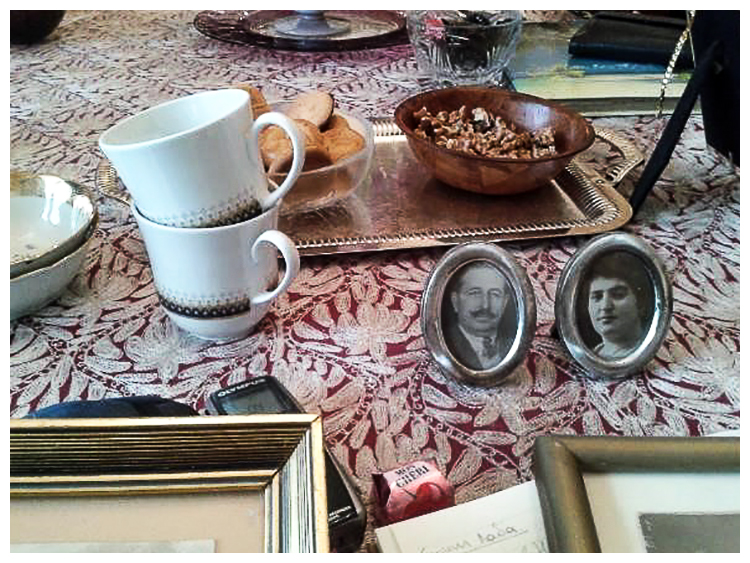
Photograph 1. From interviews in houses in the centre of the city.
The objects and the framed photographs which decorate the inside of the home and constitute, through their symbolism, an accumulated cultural and economic capital as described by Pierre Bourdieu (1984), the subject’s intentional social identity, are moved and repositioned from their initial placing and participate as actors with equal importance in the process of recollection. The informants choose particular objects in order not only to narrate or document the experiences of social and personal change or the opposite, especially for those who try to reconstruct recollections of continuity but they perform their social distinctiveness in comparison to those that do not have something to show or they do not know how to do that. This knowledge is often connected to the lifestyles and the mentalities of the “winners” of the Greek civil war and a middle class normality that seems to be hegemonic (Gramsci 1971) inside the post-war Greek society. In this article the use of the term hegemonic or that of a powerful culture/ideology is not thought to be wielded by the state through its “ideological apparatuses” as Althusser (1971) pointed out connected to a particular compounded class as that of the new bourgeois class of the 19th century as Marxist thought legacy stressed. As the recent anthropological research on the state revealed, the State itself is culturally constructed through discourses and everyday practices and this culture is always a fluid process of becoming, being influenced by different institutions and groups of people inside and outside the national states (Sharma and Gupta 2006; Hansen and Stepputat 2001; Krohn-Hansen and Nustad 2005; Steinmetz 1999).
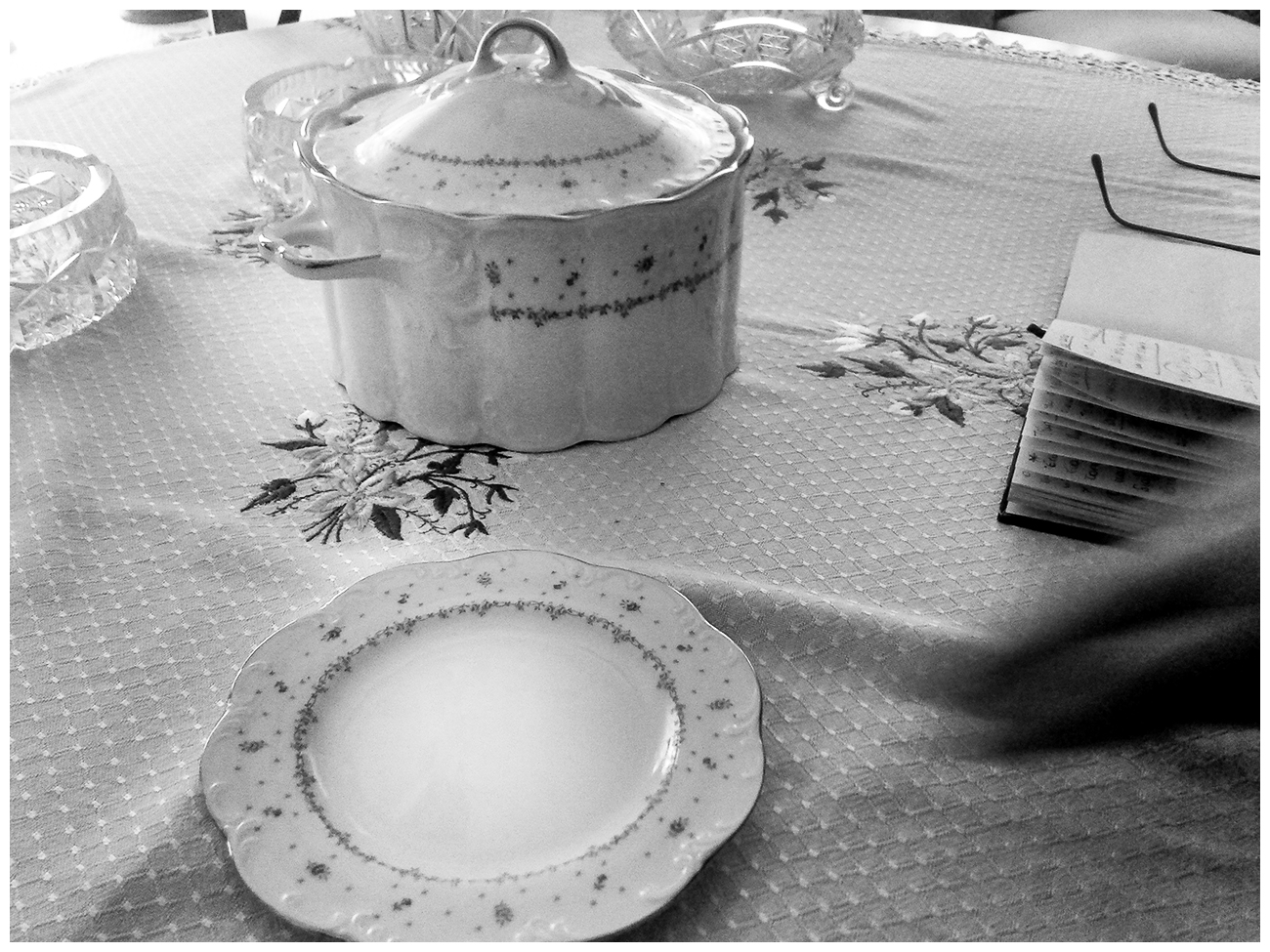
Photograph 2. Porcelain china during an interview in Kato Toumba
Additionally, it appears that the objects are agents, which can overturn the initial intentions of subjects and their presence influences the reproduction of not only the past recollections but also the self-consciousness of the subject. The apartments of the Greek middle classes are mostly decorated with framed family photographs in a repetitive style. The important moments of the family past have to be photographed and then remembered in a ‘public’ way in that they are always placed in central areas of the living room. This is not unusual in Europe and various social scientists have worked on this conventional photography and its background (Banks & Zeitlyn 2015: 85-86, Chalfen 1998). Actually, in this article I will analyse the expected “work” (Edwards 2012:221) of photographic images that my informants display in various ways in order to reproduce past social inequality and cultural distinction arguing for the status quo continuity or social upward mobility and cultural integration in the framework of post-war social and economic change of Thessaloniki.
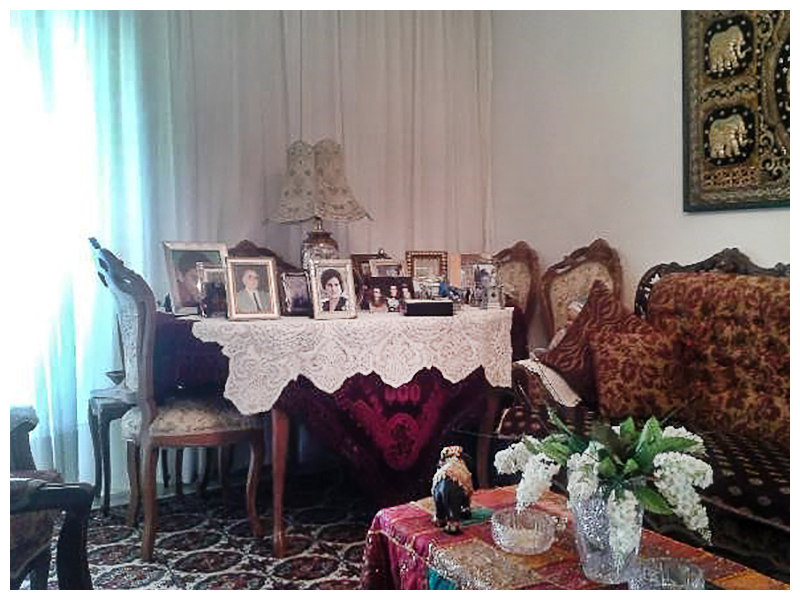
Photograph 3. The dining table in the living room of the Greek middle class household decorated, almost always, with family photographs
Family Photographs as precious heirlooms that inspire future plans and create a bridge linking discontinued family stories
Amalia is 64 years old and lives in the centre of the city in one of the most expensive and popular places of Thessaloniki, well-known for its architecture surrounding a beautiful, spacious square. From her apartment there is a direct view of the Thermaic Gulf.
Amalia is an informant who was already known to me through my family many years before I began my research project in Thessaloniki. I had not seen her for the last few years as I have been studying abroad. During the summer of 2015 I met her by chance on a main street in Thessaloniki and I approached her and introduced myself because I was not sure if she would remember me. She was really pleased to meet me again after so many years. I tried to explain my research project and asked her if it would be possible to visit her in her apartment in order to discuss the past life of the city. She was surprised and both afraid and reluctant to agree to my request she asked for some time in order to think about it and suggested that I call her again the following week. Already during our first conversation on the sidewalk of the main street, Amalia began to defend her family’s bourgeois past and explain to me her life story relating to the city’s past..
During this conversation, there was no recollection of any moments of a rupture or contradiction regarding her family past. Amalia talked only about continuity, the social importance of a powerful family of the city and her feelings of dignity and pride in her origin from Thessaloniki. After that first meeting, we talked several times on the telephone during which Amalia seemed to be still hesitant about meeting me. Instead, she continually drew attention to the fact that many books have already been published about the Thessaloniki and its past, and that she had nothing to add to these stories. It was during one of these calls that she revealed to me that she was looking for photographs of her family in order to help me with important information about the lifestyle of the city during the 1960s and 70s.
Amalia’s preparation of the relevant material intended to be shared with me reflects the feeling of responsibility for the accuracy of the information she would share. This exact sensibility was an initial signal for me to understand this heuristic way that people mobilize materials connected to particular social relations, values and family legacies in order to speak for themselves and argue for their way of life.
Edwards (2009: 132) stresses that the material practices linked to “survey photography” in the 19th century were connected to particular values and desires emerging from the need to preserve a precious past for present and future purposes while also pointing out that social relations, cultural values and materiality of things are mutually constituted.
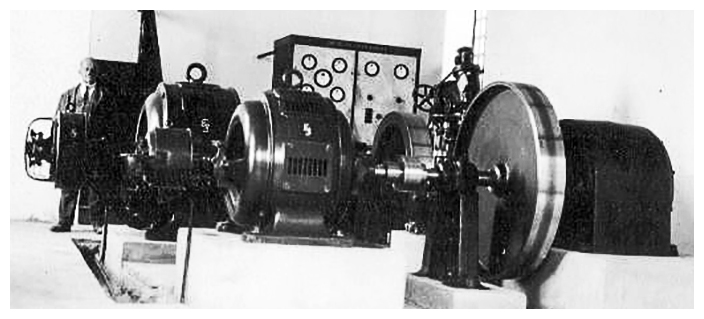
Photograph 4: This photograph depicts the interior of the family factory in the small town of the Greek prefecture of Macedonia.
Amalia originated from a family from west Greek Macedonia; her grandfather was born in Sarajevo where the family built its first factory producing clothing and fabrics. This information about the origin of her family was fragmented and less clear for my informant, making me feel uncomfortable when I tried to ask her again about other towns of origin except Thessaloniki.
After the First World War, they moved to a small town in the prefecture of Macedonia, where her family founded a new factory and a house in Neoclassical architectural style. Amalia’s ancestors always had good contacts with people in Vienna and they often visited the city. Vienna works in her narrative as a symbol of Western culture. In fact, this relationship of her family to the city of Vienna actually documents for her their Western orientation, both culturally and ideologically. This connection to an important metropolis outside the Ottoman Empire is not unusual for informants of Thessaloniki. We have to think about the role of Ottoman citizen members of the Rum millet in the Ottoman trade, especially after the Napoleonic wars, at the beginning of the modernization project in the Ottoman Empire at 19th as the great railway project that connected the state to the western big cities (Gounaris 1989; Özyüksel 2014; Somel 2003: 237, Mazower 2006).
Amalia referred to her grandmother, whom she described as a very conservative and rather harsh woman who always took exceptional care of her appearance as she and the rest of the family were very concerned with their social status. According to her, the whole town spoke of their unusual lifestyle:
“My parents and my uncles used to ride horses and dressed in European style, this impressed the ordinary people in the small town of Macedonia.”
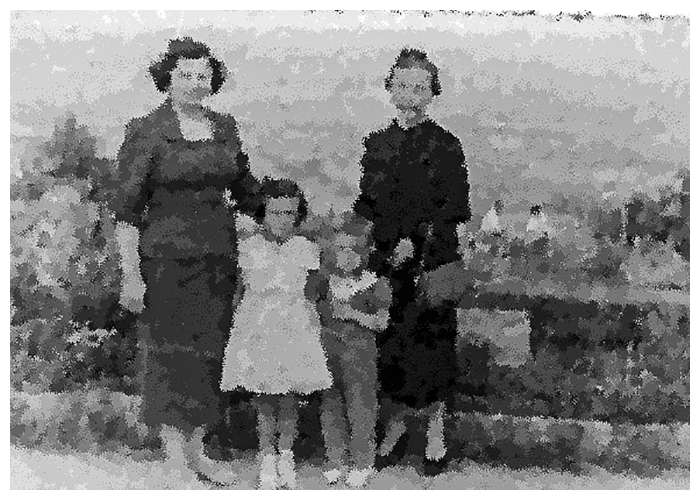
Photograph 5: This picture shows Amalia with her brother, standing between her mother and her grandmother.
In her discourses, the imagination of a combination of a western and European lifestyle connected to a special ‘Greekness’ and otherness of her family reveals the specificity of an indigenous culture that becomes again hegemonic especially after the end of the civil war under the influence of different national and western international institutions which tried to protect Greece from becoming communist. These claims of European and generally western lifestyles, imitating European bourgeois practices of 19th century, are mainly ideological and colonial in their specific art connected to particular political discourses about the question of the belonging of Greece especially in the framework of the Cold war era. However, this question was not new in terms of the Ottoman past of Greeks and the history of Greece’s State construction in the 19th century (Liakos 2001). It is rather highly connected to what Herzfeld (2002) describes as “crypto-colonialism” regarding Greece’s economic and cultural dependence in the framework of the project of European world hegemony and colonialism.
Amalia remembers vividly the year when their family business was forced to close. In 1955, ten years after the war, the workers went on strike and closed the factory for several days. This meant that the family could not manage to survive financially. They moved to Thessaloniki where they continued to conduct trade. She showed me photographs of the first family house in the small town of the prefecture of Macedonia near Thessaloniki:
“The house was built in the neo-classic style, I was used to living in this kind of home, and we never had a village house, so I don’t really know how it is to live in a village.
We belonged to the bourgeoisie of Thessaloniki; we are socially a prominent family and known by every old tenant.”
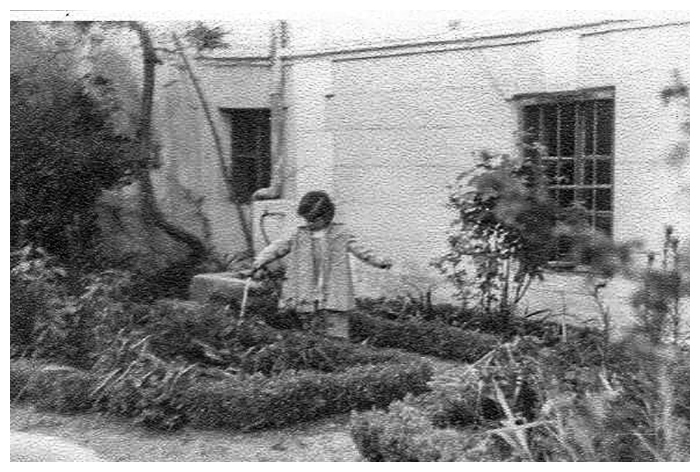
Photograph 6: Here is Amalia in the garden of the old family house in the small town of the prefecture of Macedonia
The post-war policies of the rightist regimes pursue the massive urbanization and the structural change of Greek population from highly rural to urban (Antonopoulou 1991:55-71). A lot of informants in Thessaloniki expressed their sentiments of inferiority in terms of lifestyle and ways of conduct that they experienced as they left their villages in order to migrate to the big city. In this context, Amalia’s arguments regarding her family’s bourgeois past and her belonging to an urban lifestyle explain her feeling of difference and propriety regarding the way of life that was immanent to the social group that she feels she belongs to. Her recollections were based mainly on twelve old family photographs that she had taken from her mother without permission. This fact, according to theories about ‘material circulation’ (Edwards 2012: 222-223) and their various meanings in different spaces and time, is interesting enough to think about the way that these precious objects that Amalia took from her mother, despite their initial internal narrative and the context of production, get used in the framework of our meetings in order to make obvious a family legacy that excuse her present lifestyle choices.
Amalia appeared positive to the fact that it was impossible for me to have a conversation with her mother as she, according to Amalia, is a very difficult person. She insisted on telling me that I was lucky to have been invited to her apartment as it was not her ‘way’ to be so generous with people who did not belong to her social circle. She expressed this exact point regularly during our meetings, especially when she introduced me to those of her friends whom she had decided would not be willing to help me without her patronage. My presence in the field and especially my proper appearance regarding Amalia’s cultural principles mobilized her to activate a network of people and objects, locating me at the centre of these social practices as a proper agent who can appreciate her way of life and reconnect her to several others with whom she felt to share the same values, principles and imaginations that her family photographs also documented. Amalia always stressed to her friends, as she introduced me to them, that I am conducting PhD research in a German university, always omitting to mention that I am studying in Greece at the University of Macedonia and that I only had the fortune of a one-year German scholarship in order to extend my fieldwork there. During our last meeting Amalia revealed to me that it was my attitude and more importantly my appearance, which differentiated me from my parents and this had convinced her that I was acceptable in her social circle.
Objects and people were connected around the reproduction of a ‘bourgeois’ lifestyle that had to be narrated and communicated through various heuristic ways. According to Bell (2008: 124-25), “In the process [of viewing], photographs emerge as relational or distributed objects enmeshed within various networks of telling, seeing and being which extend beyond what a photograph’s surface visually displays and incorporates, what is embodied in their materiality.”((Original cited in Edward, E. (2012 :224).))
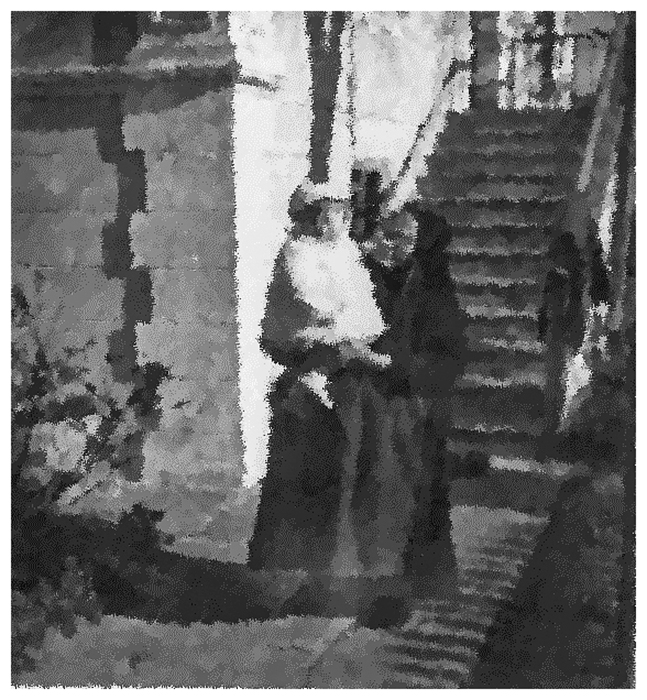
Photograph 7. Amalia, dressed in white fur, in the arms of her nanny in front of their neo-classic family house.
Amalia’s parents divorced while my informant was still attending primary school and she grew up alone with her mother. The divorce and the complete absence of her father during the years that followed the financial disaster of her father’s family company work contradict the idyllic content of the twelve family photographs. These photographic images were used in her narrative in order to materialize her intention to bridge over the period between her glorious family past, during and directly after the war, and her contemporary lifestyle and future goals/aspirations. She tried to erase both orally and with materially the gap between them, caused by her father’s family economic disaster and the divorce of her parents. Luisa Passerini in her book “Autobiography of a generation” (1968) discusses the fact that the formation of the subjectivity consists of ‘contractions, ruptures, denials and displacements’ and that the subject remembers the past in a way that is not as a constructed and absolute completed picture dragged from her memory to use during the interview. The subjects use the narrative process as a ‘way to organize experiences of the past in order to produce and explain themselves’. (Passerini 1968 p. xii) Amalia tries to be honest by giving me all the details of her family life during the hard years after the divorce of her parents, but the ‘collective memory’ (Halbwachs 1992) of a privileged bourgeois group, to which her family felt it belonged, prevents her from connecting these personal contradictions and ruptures of her family to the glorious past of a modernized, western city which developed after the war. Her narratives thus sometimes give the sense of an uninterrupted continuous life with a family playing a leading role in the city’s social and cultural change. This is also connected to the absence of any photographic display depicting the ‘difficult years’ that followed the glorious era in the neoclassic house.
I was curious to see a picture of the apartments that Amalia lived during her childhood with her mother, as her parents were divorced. It was always argued that despite the economic difficulties her mother tried to behave socially and culturally in the same way in order to maintain her social status in the big city. It is only a list of objects, written on the back of a post card that depicts the small town in Macedonia, where her mother notes down what belonged to her inside the neoclassic house.
The old photographs of her mother were initially presented to me as a source of information about the city’s past and to document the powerful social position of Amalia’s family. However, these twelve photographs, taken in the early 1950s only depict Amalia as a very young girl when her parents were still together.
The twelve photographs were inside a small box along with other old documents and objects. It was clear, right from our first appointment, that these items are extremely precious to Amalia firstly because they are tightly linked to her childhood but more importantly because these photographs work as a motivation and inspiration for her contemporary goals and everyday life. According to Edwards:
[…] “Things” such as photographs emerge as powerful and active players, extending or replacing embodied experiences and connecting with spiritual ones […]. (2009:135)
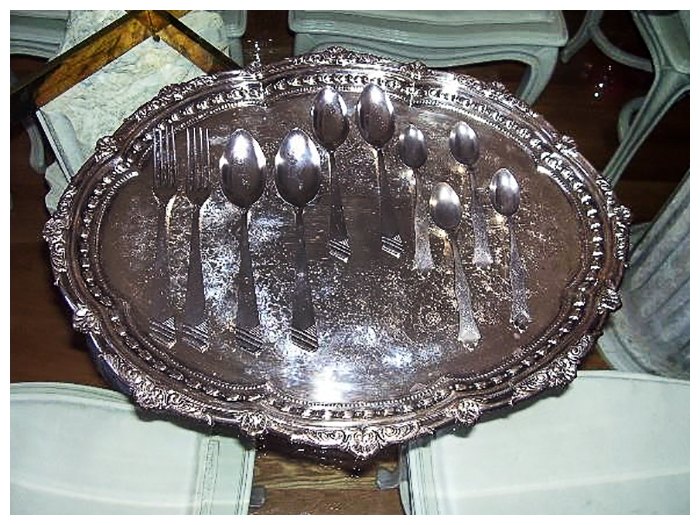
Photograph 8. This is also a photo taken by me with careful direction from Amalia to photograph the old silverware from her family, with which she used to play in the garden of the old home.
Another intriguing fact is that Amalia had no contact with her father or his family after her parents’ divorce and she also declared that she had no intention of meeting him in the near future despite his advanced age. Curiously, however, all her recollections about the city’s glorious past are related in her narratives to her father’s family and Amalia consistently parallels her contemporary lifestyle to her social achievement to this past. Her new apartment, and especially the summer residence on a Greek island, seem to be the follow up, an extended in time, space of a lost ideal family home, of the remembered family house that her grandparents lost after the economic disaster of their company. This first family home in a small town near Thessaloniki is in her recollections her favourite childhood family home perhaps because in this house her parents still lived together. These thoughts about the possible connection between the two houses were discussed spontaneously with my informant as she heuristically repositioned her precious objects in order to be photographed inside her similarly designed apartment in Thessaloniki.
The twelve photographs objectify her intention to connect these two periods of her life which seems to consist her constructed subjectivity. She is very careful while trying to get the photographs out of the small box:
“You have to scan them, because they are documents from the old bourgeois families of Thessaloniki.” She kept reminding that I must also be very careful with the photographs and she was concerned that I might lose them. During the week after our first appointment, I felt rather anxious about keeping her photographs in my house; I felt a great need to scan them as fast as possible in order to return them to her.
In her home there were no other photographs either in frames or hanging on the wall. The furnishings in her home were totally influenced, as she explained to me, by the Hellenistic and Neoclassical design, which she thought were considered to be ‘in’ in Greece during the 1980s:
“I grew up in wonderful and well-designed places, so this experience has enabled me to acquire good taste.”
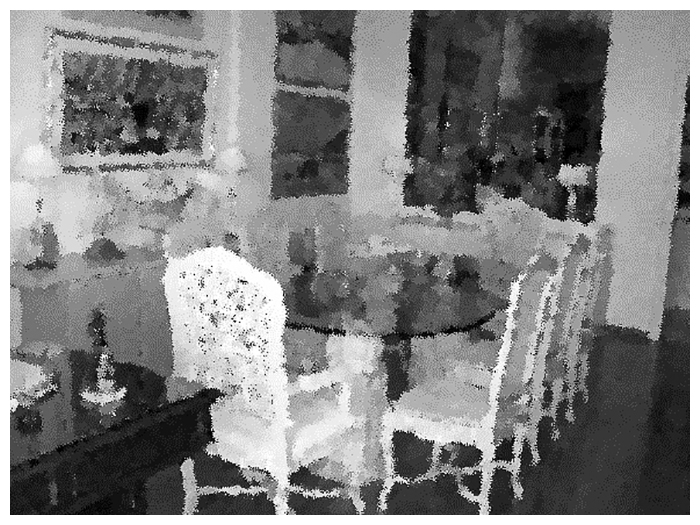
Photograph 9. This is another of my photographs, taken in the living room and completely directed by Amalia.
Amalia continued to remind me that she had created everything she had all by herself, without inheriting anything from her parents. She always tried to fill the social gap in terms of continuity between the past times of wealth and the period of financial and social disaster. She bought her apartment in the famous square because her family used to live in the old centre of the city. Amalia felt that in this way she has continued the family tradition. She showed me again the photo of the old family house and she pointed out a detail of the photograph, which was not perhaps the initial intention of the photographer but for her seems to be the “punctum” (Barthes 1980) that makes evident her special habitus.
The punctum of the photograph is not the special “air” of her father that holds her small hands as Barthes (1980) searched it in the photographs of his deceased mother; it is rather the two Viennese chairs that inspire her way of life. I think that all these connections between objects depicted in photographs, the photographs, the friends, the researcher and his proper appearance and her way of life full with objects and designs that make her happy, are pieces of an interesting puzzle that can always be completed through different ways being directed by the same imagination and social goals.
I am aware of the fact that my informants were influenced by my research interest in the socio-economic changes in Greece after the Second World War and the following civil war and their impact upon the everyday life of ordinary people in Thessaloniki. This may have prompted them to show me photographs and objects documenting a lifestyle which was contingent to the cultural and social context of the time and corresponded to the ‘master narrative’ of a particular privileged group of the city. One particularly fascinating fact is that the subjects looked again, more carefully, at their family photographs and discovered random elements which help them during our meetings to reproduce and understand themselves better in terms of their contemporary social practices and goals. These heuristic ways of display confirm their everyday practices and generate various narratives of past legacies in order to bridge over discontinued family stories and give inspiration for future plans. As Edwards states “we have to look “beyond the image”, because the photographs are “affective objects” entangled in social relations. The engagement with photographs is not only sensory feeling but rather one which is embodied (Edwards, E. 2012).
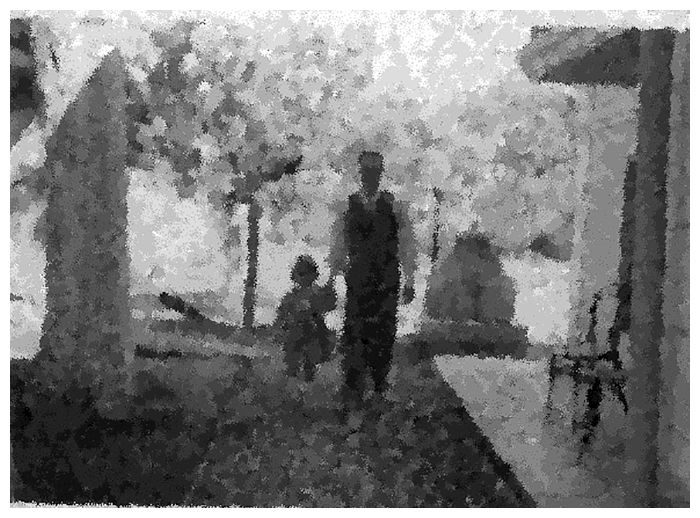
Photograph 10. Amalia with her father in the garden of the neo-classical house of her family.
The old photographs and especially their content represent fragmented pictures of a past that Amalia rediscovers in the photographs and reproduces as her recollection of past experiences which she uses additionally, in order to construct and explain her contemporary and future life choices, for example, the fact that the decoration of her apartment has to ooze elegance and luxury. It is interesting that there is no nostalgia in Amalia’s description of her relationship with her father, which is clearly the main focus of the photographer. The contemporary Neoclassical and Hellenistic design of her furnishings in her present everyday life replaces the traumatic experience of material and human loss.
“I need to wake up in a well-designed and luxurious apartment,” a statement that contradicts her view that neither the furniture nor the other decorations have to be original or expensive. Amalia often buys her furniture and other objects during the sales and tries to find the cheapest solution but this cheap solution has to look expensive and original. This consumption practices were not unusual amongst my informants in Thessaloniki, especially those who felt they belong to this special social group of a Greek Europeanized and westernized middle classes. This idea of trying to be thrifty and a good housekeeper presenting everything better than it is in reality, not telling the truth about the ways but letting the others imagine, was to found in several of my informants’ practices. This was not only connected to the problem of scarcity of the original but a kind of cleverness to get things at a better price without losing quality. For example, she reveals to me that her couch, which looks like a typical ‘Varagis’ couch is not an original. Varagis is well known in Greece as a very expensive company for classic wooden furniture and Amalia and her husband discovered another furniture factory which produced copies of their designs from where they bought their furniture of almost the same quality at a much lower price.
Another photograph shows Amalia with her younger brother: “We were sitting next to our fountain at our family home,” she tells me, “that house was very aristocratic and I believe that this was why I built something similar on the small Island of […], all the residents there laughed at me, they thought I was snobbish, but I’d never lived in a village house. This neoclassical house was the only kind of home I knew.”
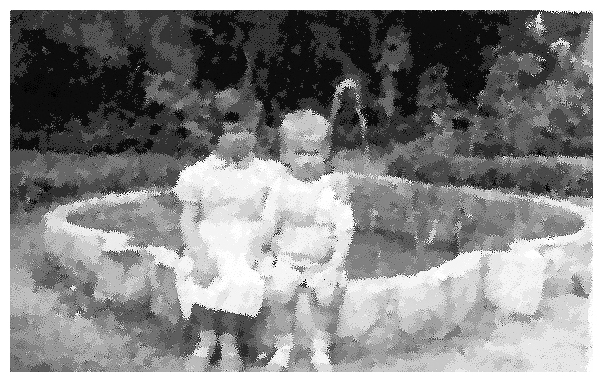
Photograph 11. Amalia with her brother in front of their home.
In 1990 Amalia built a very large neoclassical villa as a summer residence on a Greek island. This was Amalia’s major future plan that she succeeded to realize. This house was built on a plot outside the village, on the highest point of the island, where it could be easily seen by all in the small village. This house is known as ‘The Palace’. Amalia explained:
“I saw the plan of the house in a Marie Claire magazine and this reminded me of our Neo-classic family home, my family had built the house and the factory not only for themselves, but also to create something for society, buildings which would be preserved for posterity, this is our family ideology, The architectural style of the factory in […] was influenced by Neo-classical design and nowadays, although it does not belong to our family, we have left our aesthetic mark”.

Photograph 12: The Summer residence that reminds Amalia of her family home in the small town in the prefecture of Macedonia. (This is a picture that Amalia uses in her website in order to advertise her Villa to tourists interested to spend some days on the island.)
Amalia repeatedly connects her choices in life to the depicted image of the family photographs and it is, of course, a very interesting fact that she only gave me photographs from the period of time when her parents were still together and they all used to live in her grandparents’ house. Nor did Amalia show me any photos of her life with her mother after her divorce or of her life with her own husband and her daughter in the following years until the present.
The twelve photographs that she allowed me to scan are her precious objects from a past that has been reconstructed in her contemporary life and serves her intention to fill the gap of the unpleasant recollections of family ruptures and discontinuity, in terms of social power connected to her contemporary and future material achievements. They are also tightly connected to the photographs that depict her contemporary lifestyle, which she insisted that I took under her direction during our meetings inside her homes. Because of the financial crisis during the last years in Greece Amalia took out several loans to create this property and has to pay monthly a substantial amount of money in order to preserve what she has created. The state legislated for an extra tax only for real estate’s owners that forced Amalia to change the Villa to a “luxury” hotel. In her website she advertises the house through the following slogan “Luxury life at a low price”. She is anxious about losing what she succeeded to create as did her relatives. However, she is proud of leaving her personal mark as her ancestors did for posterity. Perhaps she hopes that this lifestyle and her ‘special way of life’ can be documented through my research, for she directed me to take good photographs of her interiors and what she has achieved.
In this paper the “home mode” photographs, as Chalfen (1998) firstly described the vernacular and mundane images, were interpreted, mainly in terms of their materiality and their agency being enmeshed in various social relations with other objects, their owners and the researcher. Through heuristic displays of photographic images as precious heirlooms of the past my informant understands her present and makes inspired plans for the future. Furthermore, these displays position past objects and histories inside present social relations in which the subject rediscovers herself and comprehend her choices. Banks and Zeitlyn in their book “Visual Methods in Social research” (2015) claim that “all visual forms are socially embedded” and, furthermore, are “stitched into the fabric of people’s lives, reflecting and representing social persons and social relationships […]. (Banks and Zeitlyn 2015: 115-117.) The family of Amalia’s father was able, at that particular time in Greece to capture with their own camera some moments of their everyday life and lifestyle in the small town of the prefecture of Macedonia. This is a social fact that within a specific Greek cultural context can have a particular symbolism and social value. It relates to the post-war era and especially to this social group of people that feels that it belongs to the middle classes that saved the country from the threat of communism, building a democratic and capitalistic State that understood itself as part of the western world. But this is not the point that this article wants to make regarding Visual anthropology. It is rather the heuristic use of such materials that also allows the researcher to unfold the complex net of relationships in which these photographs, as precious objects, are embedded. Furthermore, it allows him to perceive how these objects are connected to the everyday life of the subject and her present and future social practices and ambitious plans. As Banks and Zeitlyn (2015) also mentioned in their book based on the notions of material culture theories and especially the work of Daniel Miller on material objects:
“… the domestic objects, even if not used for the functional purposes, but displayed ornamentally (as doubtless the decorated plates and thimbles were), were part of an assemblage of material items within the home that conveyed meaning in conversation with one another, and with their owners and their visitors” (Banks, M. & Zeitlyn, D. 2015, p. 82).
The question is if these photographic images are only objects of equal value to the other heirlooms as the silverware that I was directed to photograph or the other materials that my subject uses and displays in front of me. It is rather difficult to answer this question thinking of the silverware that seems to function in the same way inside the complex network of relations in which the objects and their owners are entangled. The silverware reminds her of her childhood in the garden of the neo-classic house, it is evidence of a particular lifestyle of her family, and could give us information about the social relations and the sociality of the family and it is displayed in the same heuristic way inside the present network of relation in which the subject is enmeshed.
All in all, the use of ‘home mode’ images and especially their handling during the narrative process can help us to understand how the subjects reconstruct their recollections of the past in order to produce and discover themselves and construct their subjectivity within the social context of their contemporary life.
Bibliographie
Avdela Efi, 1995, “Η κοινωνική τάξη στη σύγχρονη ιστοριογραφία: από το οικονομικό δεδομένο στην πολιτισμική κατασκευή” (The Social Class in the Contemporary Historiography: from the Economical Fact to the Cultural Construction), Istorika, 22, p. 173-204.
Antonopoulou Sofia, 1991, Ο Μεταπολεμικός μετασχηματισμός της ελληνικής οικονομίας και το οικιστικό φαινόμενο 1950-1980 (The Post-War Restructure of the Greek Economy and the Housing Phenomenon), Athens, Papazisi.
Althusser Louis, 2006 [1971], “Ideology and Ideological State Apparatuses (Notes towards an Investigation)”, in Akhil Gupta and Aradhana Sharma, The Anthropology of the State, Malden, MA, Blackwell, p. 86-111.
Banks Marcus, Zeitlyn David, 2015, Visual Methods in Social Research, London, Sage Publications, 2nd ed.
Barthes Roland, 1981, Camera Lucida: Reflections on Photography, Basingstoke, Macmillan.
Bell Joshua A., 2008, “Promiscuous Things: Perspectives on Cultural Property through Photographs in the Purari Delta of Papua New Guinea”, International Journal of Cultural Property, 15, 2, p. 123-139.
Bourdieu Pierre, 1984 [1979], Distinction: A Social Critique of the Judgment of Taste, trans. by Richard Nice, Cambridge, Mass, Harvard University Press.
Bourdieu Pierre, 1999, “Rethinking the State: Genesis and Structure of the Bureaucratic Field”, in George Steinmetz (ed.), State/Culture, State-formation after the Cultural Turn, Ithaca/London, Cornell University Press, p. 53-75.
Butler Judith, 1990, Gender trouble: Gender and the Subversion of Identity, New York, Routledge.
Chalfen Richard, 1998, “Interpreting Family Photography as Pictorial Communication”, Image-Based Research: A Sourcebook for Qualitative Researchers, p. 214-234.
Drazin Adam, Frohlich David, 2007, “Good Intentions: Remembering through Framing Photographs in English Homes”, Ethnos, 72, 1, p. 51-76.
Edwards Elizabeth, 2009, “Photography and the Material Performance of the Past”, History and Theory, 48, p. 130-150
Edwards Elizabeth, 2012, “Objects of Affect: Photography Beyond the Image”, Annual Review of Anthropology, 41, p. 221-234.
Foucault Michel, 2006, “Governmentality”, in Aradhana Sharma and Akhil Gupta (eds), The Anthropology of the State: a Reader, Malden, MA, Blackwell, p. 131-142.
Gialouri Elpida (ed.), 2012, Υλικός πολιτισμός, Η ανθρωπολογία στη χώρα των πραγμάτων (Material Culture, Anthropology in the World of Objects), Alexandria.
Gounaris Basil C., 1989, “Railway Construction and Labour Availability in Macedonia in the Late Nineteenth Century”, Byzantine and Modern Greek Studies, 13, 1, p, 139-158.
Gramsci Antonio 2006 [1971], “Selections from the Prison Notebooks”, in Akhil Gupta and Aradhana Sharma, The Anthropology of the State, Malden, MA, Blackwell, p. 71-85.
Gupta Akhil, Sharma, Aradhana, The Anthropology of the State, Malden, MA, Blackwell.
Halbwachs Maurice, 1992, On Collective Memory, ed. and trans. Lewis A. Coser, Chicago/London, University of Chicago Press.
Hansen Thomas Blom (ed.), 2001, States of Imagination: Ethnographic Explorations of the Postcolonial State, Durham/London, Duke University Press.
Hastrup, Kirsten, 1998, Ιθαγενής ανθρωπολογία: Μια αντίφαση στους όρους (Indigenous Anthropology: A contradiction in Terms?), in Dimitra Gefou-Madianou (ed,), Ανθρωπολογική θεωρία και Εθνογραφία, Σύγχρονες τάσεις (Anthropological Theory and Ethnography, Contemporary trends), Athens, Ellinika Grammata.
Herzfeld Michael, 2002, “The Absence Presence: Discourses of Crypto-Colonialism”, The South Atlantic Quarterly, 101, 4, p. 899-926.
Hevia, James L., 2009, “The Photography Complex: Exposing Boxer-Era China (1900-1901)”, in Rosalind C. Morris (ed.), Photographies East: The Camera and its Histories in East and Southeast Asia, Durham, NC, Duke University Press, p. 79-99.
Hicks Dan, Beaudry Mary C. (eds), 2010, Material Culture Studies, Oxford, Oxford University Press.
Hirschon Renée, 1998, Heirs of the Greek Catastrophe: the Social Life of Asia Minor Refugees in Piraeus, New York/Oxford, Berghahn books.
Kokot Waltraud, 1996, “Kleinasienflüchtlinge in Thessaloniki: Zur Verarbeitung von Fluchterlebnissen in Biographischen Erzählungen” (Asia Minor Refugees in Thessaloniki: Revising Experiences of Escaping in Biographical Narratives), in Waltraud Kokot and Dorle Drackle (eds), Ethnologie Europas: Grenzen, Konflikte, Identitäten, p. 259-271.
Krohn-Hansen Christian, Nustad Knut G., 2005, State Formation: Anthropological Perspectives, London, Ann Arbor, MI, Pluto Press.
Liakos Antonis 2001, “The Construction of National Time: The Making of the Modern Greek Historical Imagination”, Mediterranean Historical Review, 16, 1, p. 27-42.
Maloutas Thomas, 1990, Αθήνα, Κατοικία, Οικογένεια, Ανάλυση των μεταπολεμικών πρακτικών στέγασης (Athens, Housing, Family, Analysis of the post-war housing practices), Athens, ΕΚΚΕ/Exantas.
Marcus, George E., Fischer Michael M. J., 1999, Anthropology as Cultural Critique: An Experimental Moment in the Human Sciences, Chicago, University of Chicago Press.
Mazower Mark, 2006, Salonica, City of Ghosts: Christians, Muslims and Jews 1430-1950, Vintage.
Miller Daniel, 1998, Material Cultures: Why Some Things Matter, Chicago, University of Chicago Press.
Naguib Nefissa, 2008, “Storytelling: Armenian Family Albums in the Diaspora”, Visual Anthropology, 21, 3, p. 231-244.
Oikonomou Leonidas, 2008, Η κοινωνική παραγωγή του χώρου στην μεταπολεμική Αθήνα, Η περίπτωση της Βούλας (The Social Production of Urban Space in Post-War Athens, A Case Study in Voula), Athens, Ellinika Grammata.
Özyüksel Murat 2014, The Hejaz Railway and the Ottoman Empire, Modernity, Industrialization and Ottoman Decline, London/New York, I. B. Tauris
Passerini Luisa, 1987, Fascism in Popular Memory: The Cultural Experience of the Turin Working Class, vol. 10, Cambridge, Cambridge University Press.
Passerini Luisa, 1996, Autobiography of a Generation: Italy, 1968, Hanover, Wesleyan University Press.
Somel Selcuk Aksin, 2003, Historical Dictionary of the Ottoman Empire, Lanham/Maryland/Oxford: The Scarecrow Press, Inc (Ancient civilization and Historical Eras, 7).
Steinmetz George (ed.), State/Culture, State-formation after the Cultural Turn, Ithaca/London, Cornell University Press.

Miltiadis Zermpoulis
- Cet auteur n\\\\\\\'a pas d\\\\\\\'autres publications.

